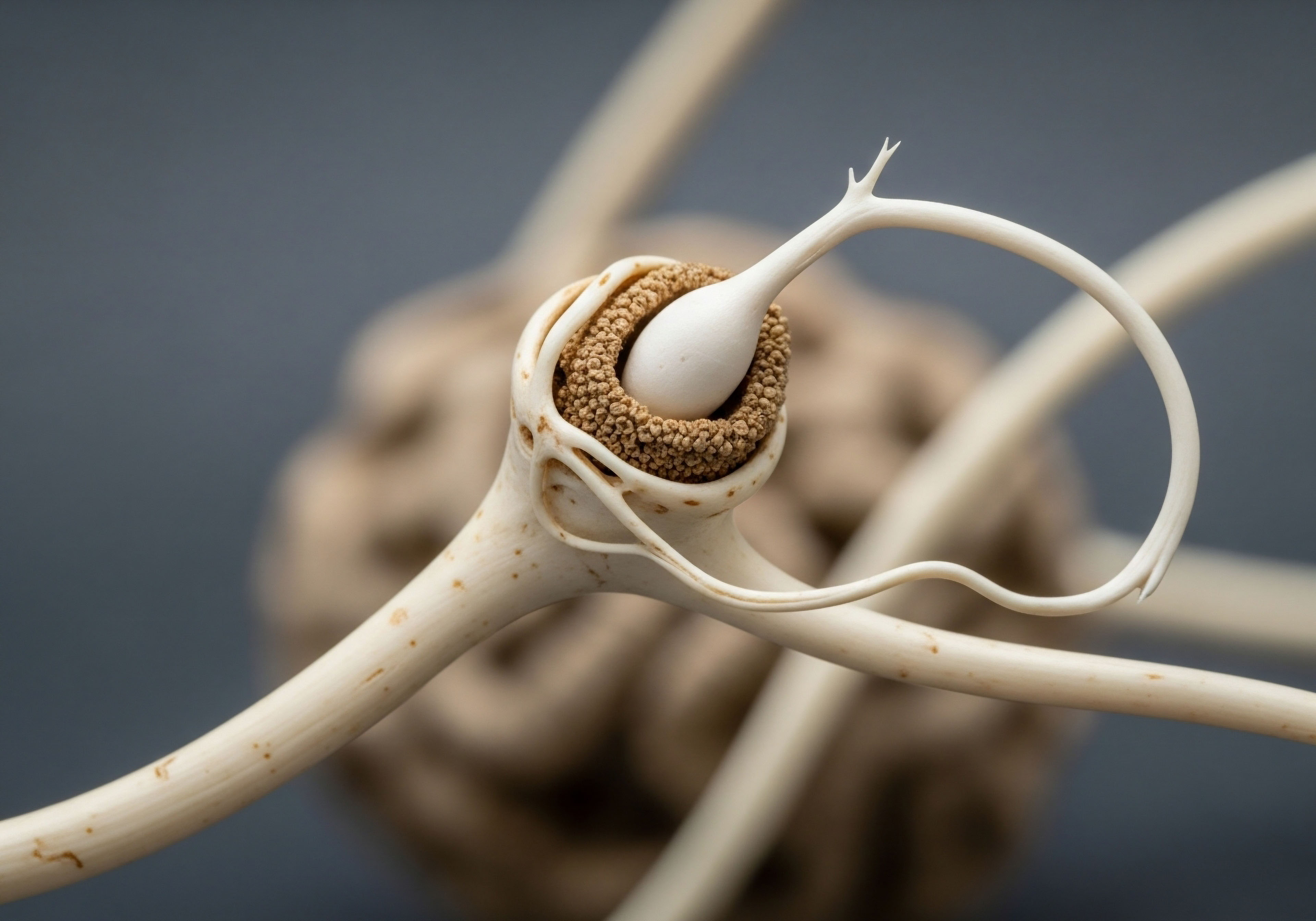

Fundamentals
You may feel a persistent, draining fatigue that defies explanation. It is a sense of compromised vitality that sleep never seems to resolve. This experience is a valid biological signal. Your body is communicating a disruption, and understanding that signal is the first step toward reclaiming your function.
The question of how sleep apnea Meaning ∞ Sleep Apnea is a medical condition characterized by recurrent episodes of partial or complete upper airway obstruction during sleep, or a cessation of respiratory effort originating from the central nervous system. affects your body’s production of testosterone begins with appreciating the profound connection between restorative sleep and the intricate orchestration of your endocrine system. Each night, your body undertakes a complex series of restorative processes, and hormonal regulation is chief among them. Testosterone production, in particular, is synchronized with your sleep cycles.
This process is governed by a precise communication network known as the Hypothalamic-Pituitary-Gonadal (HPG) axis. Think of it as a command-and-control system. The hypothalamus in your brain sends a signal, Gonadotropin-Releasing Hormone (GnRH), to the pituitary gland. The pituitary, in turn, releases Luteinizing Hormone Meaning ∞ Luteinizing Hormone, or LH, is a glycoprotein hormone synthesized and released by the anterior pituitary gland. (LH) into the bloodstream.
LH then travels to the Leydig cells in the testes, instructing them to produce and release testosterone. This entire sequence is most active during the deep stages of sleep, specifically during the first few hours after you fall asleep and in alignment with REM cycles. Your peak testosterone release is timed to coincide with this period of profound rest.

The Core Disruption of Sleep Apnea
Obstructive Sleep Apnea (OSA) introduces two primary disruptive forces into this finely tuned system ∞ sleep fragmentation Meaning ∞ Sleep fragmentation denotes the disruption of continuous sleep architecture, marked by repeated, brief awakenings or arousals throughout the night. and intermittent hypoxia. Sleep fragmentation occurs when your airway repeatedly collapses, causing your brain to briefly awaken you to resume breathing. These micro-arousals shatter the architecture of your sleep, preventing you from sustaining the deep, restorative stages required for optimal HPG axis function.
The constant interruptions mean the command-and-control system never gets to operate in its ideal state. The signals from the brain to the testes become disorganized and suppressed.
Intermittent hypoxia is the second, equally damaging component. Each time your breathing stops, the oxygen level in your blood drops. This repeated oxygen deprivation is a significant physiological stressor. Your body perceives these events as a recurring state of emergency. This hypoxic stress directly impairs the function of both the pituitary gland and the testes.
The cells responsible for sending and receiving the hormonal signals are literally starved of the oxygen they need to perform their duties effectively. The result is a direct suppression of testosterone output. The severity of the oxygen desaturation has been strongly correlated with the reduction in testosterone.
Sleep apnea disrupts the nightly hormonal maintenance cycle by fragmenting sleep and depriving the body of oxygen, directly hindering testosterone production.

Why Does This Matter for How You Feel?
The fatigue, mental fog, and low motivation you may be experiencing are direct consequences of this hormonal disruption. Testosterone is a powerful regulator of energy, mood, cognitive function, and physical strength. When its production is compromised night after night, the effects accumulate. You feel it as a decline in your overall well-being.
The issue is a cascade of physiological events, originating from a mechanical problem during sleep, which then creates a profound biochemical imbalance. Understanding this connection validates your experience. The symptoms are real because the underlying biological disruption is real.
This foundational knowledge empowers you to see your symptoms through a clinical lens. It moves the conversation from one of vague, unexplained fatigue to a clear, cause-and-effect relationship between your sleep quality and your endocrine health. The path forward begins with addressing the root mechanical issue of sleep apnea to restore the foundational integrity of your sleep architecture.


Intermediate
To appreciate the clinical significance of sleep apnea’s impact on testosterone, we must examine the specific mechanisms of endocrine disruption. The HPG axis Meaning ∞ The HPG Axis, or Hypothalamic-Pituitary-Gonadal Axis, is a fundamental neuroendocrine pathway regulating human reproductive and sexual functions. relies on a pulsatile release of hormones. The hypothalamus releases GnRH in rhythmic bursts, which in turn triggers the pituitary to release LH in a similar pulsatile fashion.
The frequency and amplitude of these LH pulses are critical for stimulating the testes. Research shows that normal men experience a significant rise in testosterone linked to the onset of sleep, particularly with the first REM sleep episode. Sleep fragmentation from OSA directly flattens this nocturnal rhythm. The constant arousals disrupt the stable, deep sleep environment necessary for the pituitary to generate high-amplitude LH pulses, leading to a blunted and disorganized testosterone secretion profile throughout the night.

The Compounding Effect of Hypoxia and Obesity
Intermittent hypoxia compounds the damage. The low oxygen levels during apneic events act as a direct stressor on the Leydig cells of the testes. This cellular stress can reduce their sensitivity to LH and impair their enzymatic machinery for testosterone synthesis.
Studies have demonstrated a negative correlation between the severity of OSA, as measured by the Apnea-Hypopnea Index (AHI), and serum testosterone levels. A higher AHI score consistently correlates with lower testosterone, indicating a dose-response relationship between the severity of the sleep disorder and the degree of endocrine dysfunction.
Obesity is a frequent co-conspirator in this scenario. Adipose tissue (body fat) is metabolically active and produces the enzyme aromatase, which converts testosterone into estrogen. Increased body fat leads to higher aromatase Meaning ∞ Aromatase is an enzyme, also known as cytochrome P450 19A1 (CYP19A1), primarily responsible for the biosynthesis of estrogens from androgen precursors. activity, further lowering free testosterone levels. Since obesity is a primary risk factor for developing OSA, many individuals find themselves in a vicious cycle.
OSA worsens, contributing to fatigue and metabolic changes that favor weight gain. The increased obesity then exacerbates both the mechanical airway obstruction and the aromatase-driven depletion of testosterone. This interplay suggests that for many men, OSA, obesity, and hypogonadism Meaning ∞ Hypogonadism describes a clinical state characterized by diminished functional activity of the gonads, leading to insufficient production of sex hormones such as testosterone in males or estrogen in females, and often impaired gamete production. are a tightly linked clinical triad.
The severity of sleep apnea directly correlates with the degree of testosterone suppression, a problem often amplified by the metabolic effects of concurrent obesity.

Evaluating the Efficacy of CPAP Therapy
Given that OSA is the root cause, the logical first-line treatment is Continuous Positive Airway Pressure (CPAP) therapy. CPAP works by providing a steady stream of air that acts as a pneumatic splint, keeping the airway open throughout the night. This resolves the primary issues of sleep fragmentation and intermittent hypoxia.
The clinical question then becomes ∞ does fixing the mechanical problem fully restore the hormonal system? The evidence here is mixed and warrants a careful interpretation. Some studies have shown that consistent CPAP use can lead to a statistically significant increase in testosterone levels.
However, a larger body of evidence, including several meta-analyses, suggests that while CPAP is essential for treating apnea itself, it does not reliably or completely reverse pre-existing hypogonadism in all men. The increase in testosterone, when observed, is often modest and may not be sufficient to bring a man from a clinically hypogonadal state back into the optimal range.
This table illustrates the physiological differences between a healthy sleep state and one compromised by OSA.
| Physiological Parameter | Normal Restorative Sleep | Obstructive Sleep Apnea (Untreated) |
|---|---|---|
| Sleep Architecture | Sustained periods of deep (N3) and REM sleep. | Fragmented; frequent micro-arousals; reduced deep and REM sleep. |
| Oxygen Saturation (SpO2) | Stable, typically above 95%. | Intermittent desaturations, often dropping below 90%. |
| LH Pulsatility | Strong, high-amplitude pulses, especially during early sleep. | Blunted, disorganized, and lower-amplitude pulses. |
| Nocturnal Testosterone Rhythm | Significant rise after sleep onset, peaking in the early morning. | Attenuated or absent nocturnal rise; lower overall levels. |
| Cortisol Pattern | Lowest levels in the first few hours of sleep. | Elevated levels due to chronic stress from arousals and hypoxia. |
This data leads to a critical clinical insight. For a man whose low testosterone is solely a consequence of mild to moderate OSA, CPAP therapy Meaning ∞ CPAP Therapy, or Continuous Positive Airway Pressure, is a medical intervention delivering pressurized air through a mask during sleep. might be sufficient to restore normal endocrine function. For a man with severe OSA, long-standing hypogonadism, or confounding factors like significant obesity, CPAP is a necessary but potentially insufficient step.
In these cases, CPAP restores the proper sleep environment, but the endocrine system may require direct support to regain optimal function. This is where a comprehensive evaluation becomes paramount, assessing both sleep metrics and a full hormonal panel after a period of consistent CPAP use.


Academic
A sophisticated analysis of how obstructive sleep apnea Meaning ∞ Obstructive Sleep Apnea (OSA) is a chronic condition marked by recurrent episodes of upper airway collapse during sleep, despite ongoing respiratory effort. mediates hypogonadism requires a systems-biology perspective. The disruption extends beyond the simple mechanics of the HPG axis. The state of chronic intermittent hypoxia and sleep fragmentation characteristic of OSA induces a systemic inflammatory response.
This environment is characterized by elevated levels of pro-inflammatory cytokines, such as Tumor Necrosis Factor-alpha (TNF-α) and Interleukin-6 (IL-6). These cytokines have direct inhibitory effects on testicular function. They can impair the steroidogenic acute regulatory (StAR) protein, which is the rate-limiting step in transporting cholesterol into the mitochondria of Leydig cells for conversion into testosterone. Therefore, the inflammatory cascade initiated by OSA actively suppresses testosterone synthesis at the gonadal level, independent of pituitary signaling.

What Is the Neuroendocrine Cascade of Disruption?
The neuroendocrine consequences are equally profound. The physiological stress of nightly apneic events leads to chronic activation of the Hypothalamic-Pituitary-Adrenal (HPA) axis, resulting in elevated cortisol Meaning ∞ Cortisol is a vital glucocorticoid hormone synthesized in the adrenal cortex, playing a central role in the body’s physiological response to stress, regulating metabolism, modulating immune function, and maintaining blood pressure. levels. Cortisol, the primary stress hormone, has a well-documented suppressive effect on the HPG axis at multiple levels.
It can inhibit GnRH release from the hypothalamus, reduce pituitary sensitivity to GnRH, and directly impair Leydig cell function. This creates a state of functional central hypogonadism driven by chronic stress physiology. Furthermore, OSA is linked to leptin resistance. Leptin, a hormone produced by fat cells, normally signals satiety and modulates GnRH release.
In states of obesity and inflammation common in OSA, the brain becomes resistant to leptin’s signals. This dysregulation contributes to both metabolic dysfunction and further suppression of the reproductive axis.
This table synthesizes findings from selected studies, highlighting the nuanced relationship between OSA treatment and testosterone levels.
| Study Focus | Patient Group | Key Findings | Clinical Implication |
|---|---|---|---|
| CPAP Efficacy on T Levels | Men with moderate to severe OSA. | Meta-analyses show inconsistent and often modest increases in testosterone. Eugonadal men show little change. | CPAP is essential for treating apnea but is not a reliable standalone therapy for restoring optimal testosterone levels. |
| OSA Severity and T Correlation | Large cohorts of middle-aged men. | A direct negative correlation exists between AHI/oxygen desaturation index and total/free testosterone levels. | The severity of sleep-disordered breathing is a primary determinant of the degree of testosterone suppression. |
| Hypoxia’s Direct Effect | Animal and human studies. | Intermittent hypoxia directly impairs Leydig cell function and disrupts the circadian rhythm of testosterone secretion. | Oxygen deprivation is a primary pathophysiological mechanism, not just a secondary effect of sleep loss. |
| TRT’s Effect on OSA | Hypogonadal men with untreated OSA. | High-dose testosterone administration can potentially worsen sleep-disordered breathing in some individuals. | OSA must be diagnosed and managed before or concurrently with the initiation of testosterone replacement therapy. |

Why Might Testosterone Replacement Be Indicated Post CPAP?
The accumulated evidence provides a clear rationale for a two-pronged diagnostic and therapeutic approach. The first step is the diagnosis and effective treatment of OSA, typically with CPAP. This removes the ongoing physiological insults of hypoxia, sleep fragmentation, and systemic inflammation. After a period of consistent CPAP use (e.g.
3-6 months), a comprehensive reassessment of the patient’s hormonal status and clinical symptoms is critical. If symptoms of hypogonadism persist and lab values confirm low testosterone, it indicates that the HPG axis has not recovered its endogenous function. This can be due to the long-term suppressive effects of the preceding OSA, underlying primary or secondary hypogonadism, or the confounding influence of obesity.
Systemic inflammation and chronic stress hormone elevation induced by sleep apnea actively suppress testicular function, a condition that may persist even after CPAP therapy.
In this scenario, initiating a formal hormonal optimization protocol becomes the logical next step. The goal is to restore physiological testosterone levels Meaning ∞ Testosterone levels denote the quantifiable concentration of the primary male sex hormone, testosterone, within an individual’s bloodstream. to alleviate symptoms and improve metabolic health. A standard, medically supervised protocol for men might involve weekly intramuscular injections of Testosterone Cypionate.
To maintain testicular function Meaning ∞ Testicular function encompasses the combined physiological roles of the testes in male reproductive health, primarily involving spermatogenesis, the production of spermatozoa, and steroidogenesis, the synthesis and secretion of androgens, predominantly testosterone. and mitigate testicular atrophy, this is often paired with a GnRH analogue like Gonadorelin, which provides the stimulatory signal that the pituitary is failing to produce. To manage potential side effects from the aromatization of testosterone into estrogen, an aromatase inhibitor like Anastrozole may be prescribed.
This comprehensive approach acknowledges that OSA and hypogonadism are distinct but interconnected pathologies. Treating the apnea is foundational, but directly addressing the persistent endocrine dysfunction is often necessary to fully restore the patient’s health and vitality.

References
- Kim, S. D. & Cho, K. S. (2019). Obstructive Sleep Apnea and Testosterone Deficiency. The World Journal of Men’s Health, 37(1), 12 ∞ 18.
- Luboshitzky, R. Aviv, A. Hefetz, A. Herer, P. Shen-Orr, Z. Lavie, L. & Lavie, P. (2002). Decreased pituitary-gonadal secretion in men with obstructive sleep apnea. The Journal of Clinical Endocrinology & Metabolism, 87(7), 3394 ∞ 3398.
- Wittert, G. (2014). The relationship between sleep disorders and testosterone in men. Asian Journal of Andrology, 16(2), 262 ∞ 265.
- Pecoraro, V. et al. (2019). Effects of CPAP on Testosterone Levels in Patients With Obstructive Sleep Apnea ∞ A Meta-Analysis Study. Frontiers in Endocrinology, 10, 551.
- Borelli, M. et al. (2022). The complex relation between obstructive sleep apnoea syndrome, hypogonadism and testosterone replacement therapy. Journal of Endocrinological Investigation, 45(11), 2029 ∞ 2040.
- Roland, A. R. & Moenter, S. M. (2011). Regulation of gonadotropin-releasing hormone neurons by stress. Stress, 14(4), 331-348.
- Carreau, S. et al. (2011). Testis and obesity. Annales d’Endocrinologie, 72(2), 144-148.
- Sartorius, G. A. et al. (2012). Serum testosterone, dihydrotestosterone and estradiol concentrations in older men self-reporting sleep problems ∞ the European Male Ageing Study. Clinical Endocrinology, 77(5), 762-771.

Reflection
You now possess a clinical framework for understanding the connection between your sleep and your vitality. The fatigue and diminished function you may have felt are not abstract complaints; they are the predictable outcomes of a specific physiological cascade. This knowledge shifts your position from one of passive suffering to one of active inquiry.
The data presented here is a map, showing the intricate pathways that link breathing, sleep quality, inflammation, and hormonal signaling. It demonstrates that your body operates as an integrated system, where a disruption in one area can echo through many others.

What Is the Next Step on Your Personal Health Journey?
This understanding is the foundational step. The path to reclaiming your optimal function is a process of systematic investigation and personalized intervention. It begins with addressing the foundational pillar of restorative sleep. From there, it involves a clear-eyed assessment of your endocrine health to determine what support your system requires to return to a state of balance and strength.
Consider this information not as a final answer, but as the set of well-formulated questions you can now bring to a clinical partnership. Your personal health journey is unique, and navigating it with this level of biological insight empowers you to seek solutions that are as precise and sophisticated as the systems they are designed to support.












